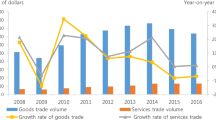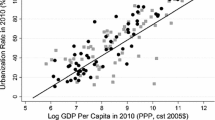Abstract
International trade has grown considerably over the last few decades. This increase can be attributed to several factors, among them a decline in international trade costs such as the decline in transportation costs and tariffs. A gap in the literature has been observed in understanding and measuring the concept of real trade costs and their impact on international trade. This paper tries to assess and estimate the impact of trade costs on international trade for main trade sectors like agriculture, manufacturing, machinery and transportation equipment, as well as chemicals. This is achieved by employing a gravity equation model and using a panel data of trade flows (2004–2014) across the 34 OECD member countries. Results demonstrate that–beyond the “classical” variables that affect trade costs–maritime transport connectivity, number of days and number of documents required for the export process are important determinants of bilateral trade costs.
Similar content being viewed by others
Notes
Conclusive evidence after studying the corresponding international figures at UNCOMTRADE.
Refer the study Anderson and Van Wincoop (2004), which has elaborately covered the major studies carried out on this subject.
Additionally, Feenstra (1998) concludes that Mattel's Barbie doll cost of transportation, marketing, wholesaling, and retailing have an ad-valorem tax equivalent of 900%.
The Liner Shipping Connectivity Index captures how well countries are connected to global shipping networks. It is computed by the United Nations Conference on Trade and Development (UNCTAD) based on five components of the maritime transport sector: number of ships, their container-carrying capacity, maximum vessel size, number of services, and number of companies that deploy container ships in a country's ports.
According to Hausman test, the null hypothesis is that the preferred model is fixed effects versus the alternative the random effects.
Observations of import flows are classified by Standard International Trade Classification (SITC), Revision 3 at 2-digit level. Following that classification and according to the identification of four sectors in the current paper’s empirical research, the agriculture sector consists of bilateral import flows classified in SITC codes 0, 1, 4 and 22. The manufacturing sector consists of mutual import flows classified in code 6, machinery equipment and equipment of transport mutual import flows in code 7, and the chemical sector’s mutual import observations in code 6.
The number of N is different among sectors due to the existence of zero trade flows.
This specific fact is possibly attributed to Hummels who in his model has not included so many variables, which would influenced trade costs. The latter can lead to an over-estimation of the influence of the used variables, in the sense that the influence of other factors can be attributed to those variables (omitted variable bias) (Wooldridge 2002).
According to type [100* (ecoefficient − 1)] (Wall 2002).
It’s worth mentioning that the specific variable was examined in sector level and was proven statistically insignificant. That’s the reason why it was excluded from the analysis.
References
Anderson J, van Wincoop E (2004) Trade Costs. J Econ Lit 42:691–751
Arvis JF, Duval Y, Shepherd B, Utoktham C (2012). Trade Costs in the Developing World: 1995–2010. ARTNeT Working Paper No. 121, December, Bangkok, ESCAP
Baldwin R, Skudelny F, Taglioni D (2005) The effects of Euro. Evidence from sectoral data. Working Paper Series Nr. 446, European Central Bank
Chen N (2004) Intra-national versus international trade in the European Union: why do national border matter? J Int Econ 63(1):93–118
Cheng IH, Wall HJ (2005) Controlling for heterogeneity in gravity models of trade and integration. Federal Reserve Bank St. Louis Rev 87(1):49–63
Disdier AC, Head K (2004) The puzzling persistence of the distance effect on bilateral trade development studies. Development studies working papers Nr. 185, Centro Studi Luca D’ Agliano
Egger P, Lassmann A (2012) The language effect in international trade. Econ Lett 116(2):221–224
Feenstra R (1998) Integration of trade and disintegration of production in the global economy. J Econ Perspect 12(4):31
Hummels D (2001) Time as a trade barrier, Department of Economics. Indiana: Purdue University, Mimeo
Khan I, Kalirajan K (2011) The impact of trade costs on exports: an empirical modeling. Econ Model 28:1341–1347
Krugman P, Obstfeld M (2009) International economics—Theory and Policy, 8th edn. Pearson Education Inc., Prentice Hall
Martinez-Zarzoso I, Nowak-Lehman D (2003) Augmented Gravity Model: an empirical application to Mercosur-European Union trade flows. J Appl Econ 6:291–316
Natos D, Mattas K, Tsakiridou E (2014) Assessing the effect of the remote geographical position of Cyprus on its agricultural exports. Oper Res Int J 14(3):453–470
Novy D (2013) Gravity redux: measuring international trade costs with panel data. Econ Inq, West Econ Assoc Int 51(1):101–121
Papadogonas T, Voulgaris F, Agiomirgianakis G (2007) Determinants of export behavior in the Greek manufacturing sector. Oper Res Int J 7(1):121–135
Skripnitchenko A, Beladi H, Koo WW (2004) Preferential trade arrangements: Impacts on agricultural trade and income. Agribusiness & Applied Economics Report No. 542. Center for Agricultural Policy and Trade Studies, North Dakota State University, Fargo, North Dakota
United Nations Economic and Social Commission for Asia and the Pacific (2012) Report on the Comprehensive Trade Costs of Lao People’s Democratic Republic Bangkok: UN ESCAP
Wooldridge JM (2002) Econometric analysis of cross section and panel data. MIT Press, Boston
WTO (2014) World Trade Report. https://www.wto.org/english/worldtrade/reports_e.htm. Accessed 14 Mar 2014
Author information
Authors and Affiliations
Corresponding author
Rights and permissions
About this article
Cite this article
Staboulis, C., Natos, D., Tsakiridou, E. et al. International trade costs in OECD countries. Oper Res Int J 20, 1177–1187 (2020). https://doi.org/10.1007/s12351-018-0388-z
Received:
Revised:
Accepted:
Published:
Issue Date:
DOI: https://doi.org/10.1007/s12351-018-0388-z




